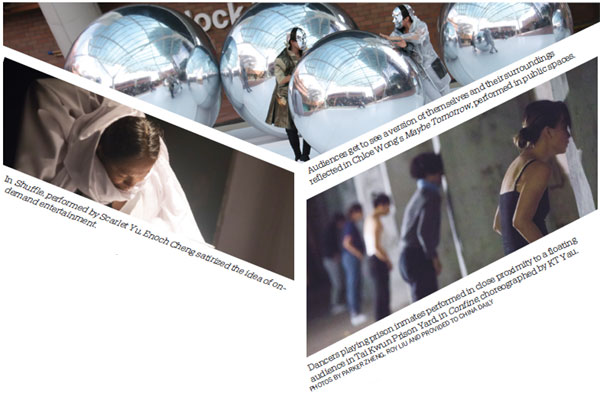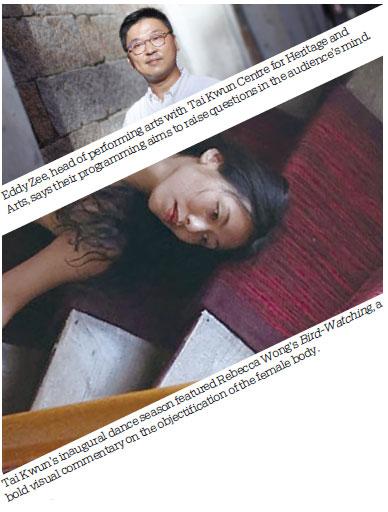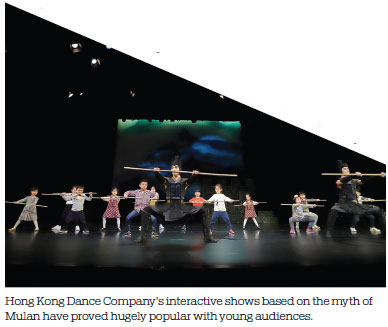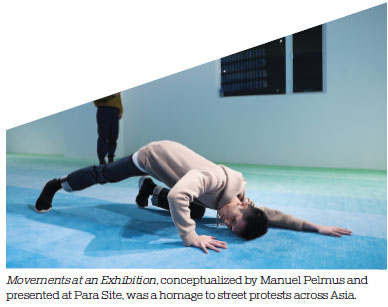Take it away, folks!
Updated: 2018-12-21 06:27
(HK Edition)
|
|||||||
In Part 3 of a series on new immersive and interactive art forms, Chitralekha Basu looks at how designers of dance and performance art events in HK are giving the audience an increased scope for exercising agency.
The audience waited in stunned silence inside F Hall at Tai Kwun Centre for Heritage and Arts. Many sat on the floor, in a close-knit arca. All eyes were on an upright nude female body. The head was trussed up inside a giant carmine red fabric cone shooting up toward the ceiling. The figure was so still it could have been a sculpture.
Then the body moved, like an angry foetus struggling to be released from the womb. The rails overhead released the fabric, draping the woman in blood colors. She paced through the crowd, shrieking like a half-formed thing. The audience stepped back, as if on cue, to give her the right of way. On she went, still agitated, squirming in and out of the drape, taking turns to throw it on a squatting audience member, and dragging his face close to hers as if she were trying to read it.
Rebecca Wong's Bird-watching, a performance piece created for the inaugural dance season of Tai Kwun in October, turned the idea of the objectification of the female body on its head. By presenting nudity in a disturbingly truncated form, Wong had managed to transfer the discomfort suffered by the victims of a consumerist gaze back on the viewer.
As Eddy Zee, head of performing arts with Tai Kwun, puts it, the point of the show "was hinged on what the viewing public made of the partial depiction of female nudity. They could see either her face or the rest of her body without a cover, but never both at the same time."
"I hope we gave the audiences a chance to question the motivations of the artiste," he adds.
Uncomfortably close
In 2018 Hong Kong witnessed a number of dance and performance art pieces which brought the audiences remarkably close to artistes, sometimes a bit too close for comfort. In October, dancers playing prison inmates locked eyes with the front-row audience and smiled dementedly in Tai Kwun's Prison Yard in the KT Yau-choreographed Confine. From December 2017 through February 2018, four performers locked arms and lay down on the floor in Para Site art gallery. Sometimes they would crawl around the space, extending their arms in a gesture of supplication. Movements at an Exhibition was a homage to the tradition of civilians in distress taking to the streets throughout Asia. As Manuel Pelmus, who choreographed the show, remarked, "It's an uncanny action (for a performer), a bit weird to be in this (supplicating) position. At the same time it is also strange for the audience to have to see someone crawling around could be potentially dangerous too."
In June, during the "M+ Live Art: Audience as Performer" shows in Goethe Institute, River Lin washed the feet of visitors while holding one-on-one conversations. His performance piece, Cleansing Service, harked back to performance art in its earliest forms when they were about folk rituals. Dressed in combat gear, the performers in the Isaac Chong Wai-choreographed Rehearsal of the Futures: Police Training Exercises hit each other and fell to the ground in slow motion, forcing the spectators to move aside or step back to make way for the falling bodies. Sometimes the performers invited people from the audience to experience the slow descent for themselves.
Hong Kong-born Chong, who lives in Berlin, says the audiences of participatory performance art aren't that different in the two cities. "Just that those in Berlin have seen many such performances, hence they are probably more quick to join, a little less shy."
Alice Teng, curator of the M+ Live Art event, seemed happy with the progress since the first edition of the show in 2015 though. That year they invited the noted Japanese dancer Eiko Otake who walked along the bustling streets of Central in a white kimono, wearing white face paint. "She lay down on the ground and started her performance and everyone just passed by, except one gentleman who had stopped to watch," remembers Teng.
However, the level of engagement demonstrated by the crowds at the 2018 event has raised her hopes. "People do enjoy being able to participate, let their hair down, some have even cried as they watched some of the performances," she observes. By the time M+ - expected to be one of Asia's largest and most modern museums of contemporary art - opens to the public in 2020, Teng is confident performance art shows that are often too abstract, impromptu and ephemeral to register as they take place will have found a venue with a better context and a more evolved audience.
"People will have more opportunities to see performance art in M+ museum and there will be greater engagement as a result," she remarks.
Giving meaning to art
Increasingly, choreographers of new dance and performance art forms in Hong Kong are in favor of writing a role for the audience in their creations. There is no pressure to participate, though. As Teng puts it, "I wanted the audience to understand that they can have the agency to create meaning in a work of art. They could experience something outside of their norms if they wished to."
The scope for exercising agency is often built into performance art pieces designed like a game. In Shuffle, performed by Scarlet Yu at City Contemporary Dance Company's San Po Kong studio in September, choreographer Enoch Cheng borrowed the idea of the good old jukebox. The audience was given a choice of dance genres - ballet, hip-hop, Cantonese opera, contemporary and waltz. Yu danced to the tune of the customers. Each time an audience member rang a bell she switched to the next piece, and the next. As the frequency of orders increased, she never quite managed to complete, or sometimes even begin, a particular piece in the set - a reflection of the consumerist patterns of consumption from which art is not exempt.
Victor Fung went the other way by encouraging people to reconnect with the young and uncorrupted side of their personalities in When I Grow Up, a piece performed simultaneously in the piazza, foyer, spiral staircase and corridors of Kwai Tsing Theatre in November as part of the New Vision Arts Festival. Six performers stopped passers-by, trying to draw them into a conversation. Invoking a now-forgotten street game from the 1970s played with rubber band chains rolled into a ball, the performers got people to share childhood stories and ultimately join a community game where 70-year-olds happily jumped around with small children.
"Growing up is a universal experience and it's possible to find common ground in several different ways," says Fung. "I wanted to shake up the hierarchy between choreographer-dancer and audience by a bit, bring them at more or less the same level."
"I wanted to make a piece designed specifically for one person, a one-to-one exchange between two people where the conversation is both verbal and also at the level of body movements," he adds.
Mirror of the times
Chloe Wong, who like Fung is eager to experiment with unconventional locations ("I would like to do shows in Exchange Square, Central, except we'd cause a traffic jam in half an hour") is showing her new composition, Maybe Tomorrow, in Hong Kong's university campus compounds in November and December. Developed under the aegis of Hong Kong Arts Development Council as part of its Jockey Club New Arts Power series, the show features masked performers trying to hold up or climb up on top of five giant inflatable balls, sliding down immediately afterwards as an inevitable consequence.
Wong connected the Greek myth of Sisyphus (who was tasked with pushing a boulder up a steep hill, only to have it roll down each time he came close to the summit) with the life of Hong Kong professionals who "often pursue goals with such singular focus that they forget to think about why they are doing it".
"At a point in the show the dancers offer the ball to the audience to touch and play with," says Wong, hastening to add that she is more interested in being able to connect with her audience at an abstract, poetic level. "Although I am willing to reach out to people, get them interested, I wouldn't want everything to fall in place and be self-explanatory."
One of the key elements in Maybe Tomorrow is that the balls also serve as a mirror, although a distorted one, in which the audiences see a version of themselves and their surroundings reflected. Hopefully the show will reveal something about themselves and the city to its audiences.
Mulan, the heart-stealer
Jimmy Wu, a geeky Primary Three student, wasn't sure he would enjoy trying out a few martial arts moves until he was called up on stage at Sha Tin Town Hall, where Hong Kong Dance Company was holding an educational show of Mulan earlier this year. While learning to work the stick did not exactly make him a fan of martial arts or dance (he would rather stick to his books), Wu said he loved "how brave Mulan was and that she stood in for her old father to serve in the battle. They seemed to be very happy when they met each other again after her time in the army."
Yang Yuntao, artistic director of Hong Kong Dance Company, was visibly moved when we shared the story. "Filial ties are quite obvious in Mulan but I wasn't sure if kids are actually able to feel it," says Yang. "Familial bonding and respecting one's elders is very deeply rooted in traditional Chinese culture but kids these days do not seem to feel as passionate about upholding those values. So it's great to hear a small boy who came to our show actually felt it."
"I for one would like children to feel the great value of family ties for themselves, and take away what they want from the show. It's only a process which will, I hope, inspire something in them," he adds.
A modified version of the show, Get-to-know Mulan, with a special focus on the "traditional Chinese virtues of courage, loyalty, wisdom and filial piety" returns to the stage in March 2019.
Could young Jimmy Wu have something to do with it?
Contact the writer at
basu@chinadailyhk.com





(HK Edition 12/21/2018 page11)